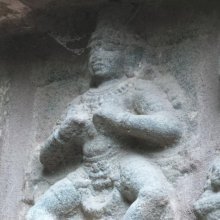Urnanabha, Urna-nabha, Urṇanābha, Ūrṇanābha: 14 definitions
Introduction:
Urnanabha means something in Hinduism, Sanskrit, Hindi. If you want to know the exact meaning, history, etymology or English translation of this term then check out the descriptions on this page. Add your comment or reference to a book if you want to contribute to this summary article.
Alternative spellings of this word include Urnnabh.
Images (photo gallery)
In Hinduism
Natyashastra (theatrics and dramaturgy)
Source: Wisdom Library: Nāṭya-śāstraŪrṇanābha (ऊर्णनाभ, “spider”) refers to a gesture (āṅgika) made with a ‘single hand’ (asaṃyuta), according to the Nāṭyaśāstra chapter 8. The hands (hasta) form a part of the human body which represents one of the six major limbs (aṅga) used in dramatic performance. With these limbs are made the various gestures (āṅgika), which form a part of the histrionic representation (abhinaya).
(Instructions of Ūrṇanābha): The fingers of the padmakośa hand further bent. (Uses of Ūrṇanābha): It is used to represent holding one by hair, receiving stolen goods, scratching one’s head, skin disease, lions, tigers and such other animals, and seizing a stone.
Source: archive.org: The mirror of gesture (abhinaya-darpana)One of the additional Single Hands (hasta):—Urṇa-nābha (spider): the fingers of the Padmakośa hand are bent. It originates from Narasiṃha when he was tearing thebody of the Daitya (Hiraṇyakaśipu) . Its sage is Sārdulaka,its race Kṣattriya, its colour blood-red, its patron deity the Primal Tortoise (Kurmāvatāra of Viṣṇu). Usage: scratching the head, theft, Narasiṃha, face of a deer, lion, monkey, tortoise, karṇikara, breast, fear, Kṣattriya caste, blood-red colour.

Natyashastra (नाट्यशास्त्र, nāṭyaśāstra) refers to both the ancient Indian tradition (shastra) of performing arts, (natya—theatrics, drama, dance, music), as well as the name of a Sanskrit work dealing with these subjects. It also teaches the rules for composing Dramatic plays (nataka), construction and performance of Theater, and Poetic works (kavya).
Purana and Itihasa (epic history)
Source: archive.org: Puranic EncyclopediaŪrṇanābha (ऊर्णनाभ).—(SUDARŚANA). A son of Dhṛtarāṣṭra. (Mahābhārata Ādi Parva, Chapter 67, Stanza 96). It is mentioned in Mahābhārata, Droṇa Parva, Chapter 127, Verse 67, that Bhīmasena killed him.
Source: Cologne Digital Sanskrit Dictionaries: The Purana IndexŪrṇanābha (ऊर्णनाभ).—One of Danu's sons.*
- * Vāyu-purāṇa 68. 9.

The Purana (पुराण, purāṇas) refers to Sanskrit literature preserving ancient India’s vast cultural history, including historical legends, religious ceremonies, various arts and sciences. The eighteen mahapuranas total over 400,000 shlokas (metrical couplets) and date to at least several centuries BCE.
Vaishnavism (Vaishava dharma)
Source: Devotees Vaishnavas: Śrī Garga SaṃhitāŪrṇanābha (ऊर्णनाभ) refers to a “spider” (whose web is the universe), used to symbolically represent Brahmā, in to the Gargasaṃhitā chapter 6.3. Accordingly, “[...] by his mystic power he [viz., Raivata] traveled to Brahmaloka. His intention to ask for a proper husband for his daughter, he bowed before the demigod Brahmā. As the Apsarā Pūrvacitti was singing, he found his opportunity. Aware that now he had Brahmā’s attention, he spoke what was in his heart: ‘[...] This universe is like a small āmalaka fruit in your hand. You are like a charioteer driving this universe through the modes of nature. You are like a spider (ūrṇanābha) and this universe is your web. In the future you will swallow up this entire universe’”.

Vaishnava (वैष्णव, vaiṣṇava) or vaishnavism (vaiṣṇavism) represents a tradition of Hinduism worshipping Vishnu as the supreme Lord. Similar to the Shaktism and Shaivism traditions, Vaishnavism also developed as an individual movement, famous for its exposition of the dashavatara (‘ten avatars of Vishnu’).
Languages of India and abroad
Sanskrit dictionary
Source: DDSA: The practical Sanskrit-English dictionaryUrṇanābha (उर्णनाभ).—A spider; cf. ऊर्णनाभ (ūrṇanābha).
Derivable forms: urṇanābhaḥ (उर्णनाभः).
--- OR ---
Ūrṇanābha (ऊर्णनाभ).—a spider; यस्तूर्णनाभ इव तन्तुभिः (yastūrṇanābha iva tantubhiḥ) Śvet.6.1; यथोर्णनाभिः सृजते गृह्णते च (yathorṇanābhiḥ sṛjate gṛhṇate ca) Muṇḍ. Up.1.1.7. विश्वं सृजसि पास्यत्सि क्रीडन्नूर्णपटो यथा (viśvaṃ sṛjasi pāsyatsi krīḍannūrṇapaṭo yathā) Bhāgavata 4.6.43.
Derivable forms: ūrṇanābhaḥ (ऊर्णनाभः).
Ūrṇanābha is a Sanskrit compound consisting of the terms ūrṇa and nābha (नाभ). See also (synonyms): ūrṇanābhi, ūrṇapaṭa, ūrṇavābhi.
Source: Cologne Digital Sanskrit Dictionaries: Shabda-Sagara Sanskrit-English DictionaryUrṇanābha (उर्णनाभ).—m.
(-bhaḥ) A spider. E. urṇa wool, nābhi a navel, affix ḍa.
--- OR ---
Ūrṇanābha (ऊर्णनाभ).—m.
(-bhaḥ) A spider. E. ūrṇa wool, nābhi the navel, ḍa affix; also ūrṇanābhi, the final being retained.
Source: Cologne Digital Sanskrit Dictionaries: Cappeller Sanskrit-English DictionaryŪrṇanābha (ऊर्णनाभ).—[masculine] spider (wool-navel).
Source: Cologne Digital Sanskrit Dictionaries: Monier-Williams Sanskrit-English Dictionary1) Ūrṇanābha (ऊर्णनाभ):—[=ūrṇa-nābha] [from ūrṇa > ūrṇu] m. ‘having wool on the navel’, a spider, [Śvetāśvatara-upaniṣad] etc.
2) [v.s. ...] a particular position of the hands
3) [v.s. ...] Name of a son of Dhṛta-rāṣṭra, [Mahābhārata]
4) [v.s. ...] of a Dānava, [Harivaṃśa]
5) [v.s. ...] Name of a people [gana] rājaṇyādi, [Pāṇini 4-2, 53.]
Source: Cologne Digital Sanskrit Dictionaries: Yates Sanskrit-English Dictionary1) Urṇanābha (उर्णनाभ):—[urṇa-nābha] (bhaḥ) 1. m. A spider.
2) Ūrṇanābha (ऊर्णनाभ):—[ūrṇa-nābha] (bhaḥ) 1. m. A spider.
[Sanskrit to German]
Sanskrit, also spelled संस्कृतम् (saṃskṛtam), is an ancient language of India commonly seen as the grandmother of the Indo-European language family (even English!). Closely allied with Prakrit and Pali, Sanskrit is more exhaustive in both grammar and terms and has the most extensive collection of literature in the world, greatly surpassing its sister-languages Greek and Latin.
Hindi dictionary
Source: DDSA: A practical Hindi-English dictionaryŪrṇanābha (ऊर्णनाभ) [Also spelled urnnabh]:—(nm) a spider.
...
Kannada-English dictionary
Source: Alar: Kannada-English corpusŪrṇanābha (ಊರ್ಣನಾಭ):—
1) [noun] the spider that has spinnerets that spin the silk threads to make nests.
2) [noun] (dance.) a single-hand gesture with hollowed palm, finger separated and slightly bent as in representing the claws of lions, tigers or combing hair or scratching one’s head etc. or as if to hold a globe.
Kannada is a Dravidian language (as opposed to the Indo-European language family) mainly spoken in the southwestern region of India.
See also (Relevant definitions)
Ends with: Aurnanabha, Churnanabha, Curnanabha.
Full-text: Aurnanabha, Urnanabhi, Aurnanabhaka, Karkata, Urnnabh, Hasta, Urnavabhi, Urnapata, Asamyuta, Hastamalaka, Gah.
Relevant text
Search found 8 books and stories containing Urnanabha, Urṇa-nābha, Ūrṇa-nābha, Urna-nabha, Urṇanābha, Ūrṇanābha; (plurals include: Urnanabhas, nābhas, nabhas, Urṇanābhas, Ūrṇanābhas). You can also click to the full overview containing English textual excerpts. Below are direct links for the most relevant articles:
Abhinaya-darpana (English) (by Ananda Coomaraswamy)
The Tattvasangraha [with commentary] (by Ganganatha Jha)
Verse 153-154 < [Chapter 6 - Doctrine of the Spirit (puruṣa) Personality as cause of the world]
Mahabharata (English) (by Kisari Mohan Ganguli)
Puranic encyclopaedia (by Vettam Mani)
Harivamsha Purana (by Manmatha Nath Dutt)
Chapter 3 - An Account of Various Families; Daksha’s Offspring < [Book 1 - Harivamsa Parva]
The Agni Purana (by N. Gangadharan)

